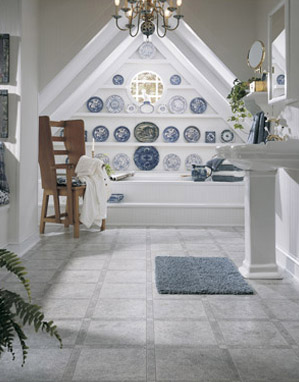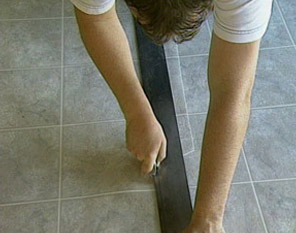Before Your Vinyl Flooring Arrives
Know what to expect before installation day.
Owning a home, it seems, is all about being prepared. Preparing your home for seasonal changes, preparing for guests and now preparing for the arrival of new vinyl flooring.
Being ready for the installation of your new vinyl flooring will make the entire process go faster, more efficiently, and hopefully eliminate any “surprises.”
Tip #1: there’s a resource for worry-free installation – it’s us.
Installing a vinyl floor is a difficult, labor intensive, very exacting process that requires full knowledge of substrates.
We strongly suggest you call upon our reliable and seasoned professionals to install your vinyl flooring.That way you can be assured of a beautiful, efficient and correct installation.
However, while installing vinyl flooring is a skill that is developed through years of experience, your understanding of the basics of installation will increase your knowledge of the process, and enhance your confidence in the professionals working in your home.
Subfloor preparation is step one.
As with most flooring products, the first step is to prepare the substrate, the surface on which the vinyl flooring will be laid.
If installing over a wood substrate, an underlayment will generally be necessary.
Installing over a concrete substrate will not require an underlayment but will require some floor preparation.
You will need to give attention to the height of your appliances to counters and cabinets if an underlayment is required.
Can you install new vinyl flooring over existing vinyl flooring?
In some cases, yes. However, it is strongly recommended that existing flooring be removed, to ensure a proper high quality installation This is where employing our experienced flooring professionals really pays off.
We can determine if your existing vinyl flooring is acceptable or if it will need to be removed.
There are three methods used to install vinyl flooring depending on manufacturer and style: Full Spread, Perimeter Adhered or Floating.
Full Spread means the adhesive is trowled over the entire substrate.
Perimeter Adhered is an installation method in which adhesive is only applied to the perimeter of the flooring and also at the seams.
Floating is a type of installation in which the vinyl flooring is not bonded to the substrate by any adhesive.
Your beautiful new vinyl floor will be professionally installed using one of those three methods.
What to know and do before installation day
Relocate your furniture.
Remove all furniture and other objects and materials from the areas to be floored. Before moving, you’ll also need to empty the contents of china cabinets, closets and the like.
Be aware that the area of installation must be climate controlled (heated or air conditioned). Vinyl flooring manufacturers recommend indoor humidity to be maintained between 40% to 50%, and the temperature not to fall below 65 or rise above 100 degrees.
What’s to be done with your present floor covering?
Please consider how your old floor covering will be taken up and disposed of. This can be a time consuming and messy task. We will be happy to discuss removal options with you.
If you prefer to remove your present floor covering yourself, do it at least one day prior to installation to allow for cleanup and floor preparation. If removing old carpet, please leave tack strips in place and pull the staples out of the floor from the original pad.
Now turn your attention to the trim.
You should know that, in many cases, moldings and baseboards need to be removed for vinyl flooring installation. Our installers will do this for an additional charge but will not be responsible for damage or breakage due to dry or brittle wood.
Painted baseboards, woodwork and paint may need retouching after the installation is complete. If necessary, this is your responsibility.
Get expert council on your sub flooring.
Your existing sub floor may need to be prepared to receive the vinyl, or a new subfloor may be required. This is a job best left to the professionals and, again, we can help you with these decisions.
It is important that the subfloor be as clean and level. That helps insure your new vinyl flooring will be as beautiful and well supported as possible and ultimately covered by the manufacturer’s warranty.
Include a door plan in your preparation.
When vinyl flooring is installed, there’s always the possibility that the doors, especially closet doors, basement and bedroom doors, may not clear the new floor and swing free.
Our installers may remove doors in order to install the vinyl and re-hang them at an additional cost. If there is a clearance issue you may want to arrange for a qualified carpenter to shave or cut down your door(s) after the installation of your new vinyl floor.
Don’t let clean-up be a toss-up.
Installing new vinyl flooring will produce waste. These materials will be collected and disposed of by our installers at an additional cost.
What to know and do during installation day
On installation day be home and handy.
Be prepared to be at home the day of installation and be available in case our installation crew has questions. Your presence will insure that the correct vinyl is installed in the right areas. Because it is difficult to estimate the length and circumstances of each job, we may not be able to give you an exact time of arrival but we will provide a time frame.
Your family is our concern.
Our installers will use a variety of tools and techniques that can make the work area hazardous. Please make sure that your children and pets are kept out of the work area on installation day.
Follow through with a walk-thru.
We recommend that, prior to the completion of the installation; you walk thru the job with our installation team. This will give you the opportunity to ask questions and be clear on any final details.
What to do after installation
Time and temp are important.
For a minimum of 24 hours after your new vinyl floor is installed, protect all the seamed areas, don't walk on them or the seam sealer.
Keep the room at a temperature not less than 68° F or greater than 100° F for at least 2 days after installation to allow the adhesives to setup properly.
If you are sensitive to dust and odors, good ventilation should be established for 48 to 72 hours after installation.
If your vinyl floor was installed using the Full Spread method, no appliances should be moved for a minimum of 24-72 hours after installation. Light foot traffic is allowed after 24 hours.
If the Perimeter Adhered installation method was utilized, no appliances should be moved for a minimum of 24-72 hours after installation. Light foot traffic is allowed after 24 hours.
If our installers used the Floating method, appliances can be moved in immediately and foot traffic is OK immediately following installation.
When you are ready to move appliances back into the room, an underlayment type of product such as plywood or particleboard with a minimum thickness of 3/8,” placed on the new flooring prior to moving the appliances, will greatly reduce any mishaps.
Do not rely on the wheels that may be attached to the refrigerator to move the appliance back in -- they can cause damage to the new floor.
Allow 5 days before thoroughly washing your floor. This will give time for the adhesive to cure.
Being prepared is the result of being informed.
We want you to be as well prepared as possible for the installation of your new vinyl flooring. To that end we’ve assembled the most knowledgeable sales people and the most experienced installers to provide you with solid information, reliable resources and proven solutions.
We hope that the information we’ve featured here leads you to a better understanding of how to prepare for installation day.


